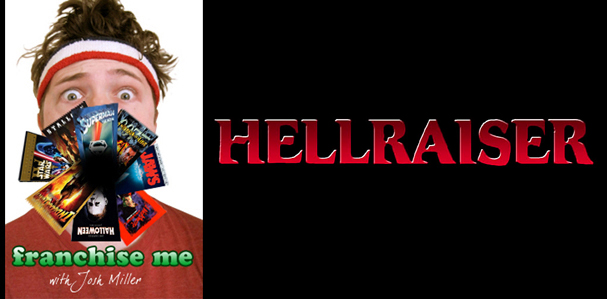
Hollywood loves a good franchise. The movie-going public does too. Horror, action, comedy, sci-fi, western, no genre is safe. And any film, no matter how seemingly stand-alone, conclusive, or inappropriate to sequel, could generate an expansive franchise. They are legion. We are surrounded. But a champion has risen from the rabble to defend us. Me. I have donned my sweats and taken up cinema’s gauntlet. Don’t try this at home. I am a professional.
Let’s be buddies on the Facebookz!
The Franchise: Hellraiser — concerning a supernatural puzzle box (and those humans foolish/unlucky enough to solve it) that opens a doorway to the hellish dimension of Pinhead, the most prominent member of the Cenobites, powerful beings who desire human souls for sadomasochistic experiments. Adapted from Clive Barker’s novella The Hellbound Heart, the franchise spans nine films, from 1987 to 2011.
previous installments
Hellraiser
Hellbound: Hellraiser II
Hellraiser III: Hell on Earth
Hellraiser IV: Bloodline
Hellraiser: Inferno
Hellraiser: Hellseeker
Hellraiser: Deader
The Installment: Hellraiser: Hellworld (2005)
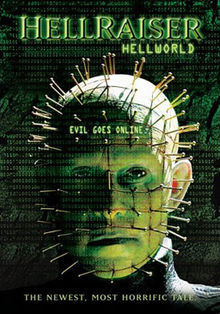
The Story:
Okay, so in this universe Hellraiser is a real thing. Sort of. Pinhead is a famous popular character, as is the Lament Configuration and its creator LeMerchant (or possibly it’s the proper “Lemarchand” spelling from Barker’s novella; I can’t quite tell which they’re saying). Only these characters and elements are all from an immersive on-line computer game called “Hellworld.” The film begins with Chelsea (Katheryn Winnick) and her friends attending the funeral of Adam, a fellow Hellworld player, who became so obsessed with the game that he wound up committing suicide. Then we jump forward in time two years. Chelsea has tried to put Hellworld behind her, but when her friends win invitations to a big Hellworld party, she gets roped in. The party is being thrown in the middle of no where by a nameless LeMerchant enthusiast (Lance Henriksen), inside a big spooky mansion which is allegedly a former convent and asylum built by LeMerchant. As the night progresses Chelsea’s friends get picked off one by one by Pinhead and his cronies — or do they? Are the Cenobites real, or is this all the work of the party’s host? Spoiler: it’s all the host. The host is actually Adam’s dad, who blames his son’s friends and their Hellworld antics for the suicide. So the dad wanted revenge and used Hellworld to get back at them. All their Cenobite interactions were hallucinations. The Cenobites aren’t real… until they are right at the end! Oh snap!
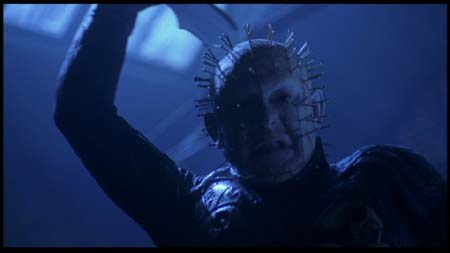
What Works:
Hellworld and Deader were shot back to back (by Rick Bota), both using concepts that weren’t originally intended to exist within the Hellraiser universe (Hellworld was intended to be a film called Dark Can’t Breathe, written by Joel Soisson). The re-purposed script approach left Deader existentially confused, trapped awkwardly between the movie it had been and the movie it was later forced to be. The major problem was that Deader had to jump through too many hoops to connect the dots between its Deaders concept and anything to do with Hellraiser. In a strange way Hellworld‘s stupid-ass concept actually helped it in this respect. Undoubtedly, Dark Can’t Breathe had its own made up video game with its own elaborate mythology that came alive in the characters’ minds at this party. All Rick Bota and co. had to do was swap all that out for the Hellraiser mythos. And because Dark Can’t Breathe already had a twist ending that completely negated all the fantastical/horrific events in the film, it doesn’t much matter if any of it makes much sense or works appropriately. For example, when Pinhead kills a guy by chopping his head off with a fucking ax there is no way not to call bullshit. Pinhead doesn’t kill people with axes! Why not just give him a shotgun? But wait… not only did that not happen, but unlike in the previous STV sequels, Pinhead isn’t even responsible for making the character think it happened. You see, Henriksen drugged the kids at the beginning of the party, so no matter how stupid or illogical what we see is, the illogicality can all be blamed on the kids’ own shitty imagination. It’s the ultimate cop-out. Sure, it doesn’t ultimately make for a great movie, but at least it didn’t leave me surly with a head full of continuity fuckholes.
Oh, Lance Henriksen. What went wrong? Even during the heyiest days of his heyday the man was always a genre character actor, but I’ll never understand why Henriksen’s career was ghettoized to the shallow end of the genre pool after Millenium went off the air — a shallow end befouled with floating turds and urine slicks. Henriksen is splendidly in form in Hellworld, especially considering the weak material he is given. Whether he found something in the character to latch onto or is just that talented, he actually seems to be having a good time; which ups the viewing pleasure every moment he’s on camera. I couldn’t have cared less about our “heroes,” but Lance makes things passable. Honestly, I could have really gotten into the swing of things if this had just been a regular ol’ slasher movie, in the vein of Maniac or Driller Killer, following Henriksen around as he bumps off obnoxious college kids in his mansion. Hellworld kind of works as unremarkable, brainless kids-picked-off-at-a-party horror entertainment because either Henriksen or Doug Bradley shows up every few minutes to distract us from our terrible 20somethings.
From purely a franchise perspective, Hellworld is easily the worst Hellraiser film we’ve had yet. Up until the epilogue, when the Cenobites nonsensically turn out to be real (I refuse to grant the film the credit required for me to go into any greater analysis of this “revelation”), we’re dealing with a Friday the 13th V gimmick, in which the Pinhead we’ve seen turns out to not in fact be Pinhead. Moreover, the movie completely ignores the Cenobite rules we’ve already established left and right. But these failings are saved by the fact that Hellworld is also the New Nightmare of the franchise too, in which Pinhead is a known and fictional commodity, and we’re ostensibly in the “real world.” None of this is cool, mind you, but given that we’re eight installments into a franchise that probably should’ve stopped around the third entry, I appreciate the abstract nature of Hellworld. Cause, hey, after smelling vomit for a couple hours, a fart right in your face is a welcome change of pace. And the film wisely uses this meta gimmick to get around its rule breaking, as our heroes note that the Cenobites shouldn’t be after them because none of them solved the Lament Configuration. There are even a couple decent meta inside jokes, like when Chelsea thinks she’s figured it all out, telling the Host that she knows he is going to “morph into Pinhead” — a good jab at the lame James Remar twist in Inferno. Though, really, Hellworld has no right to cast stones. Particularly regarding idiotic twist endings. And even though there are a few bright spots in the meta approach…
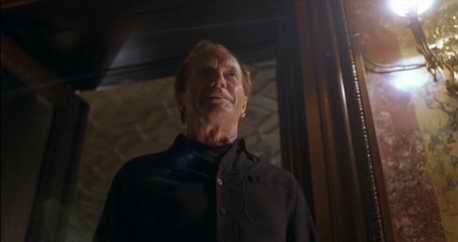
What Doesn’t Work:
…it is mostly a blown opportunity and low-level contextual clusterfuck. They didn’t need to go the New Nightmare route and have Clive Barker and Doug Bradley as characters in the movie (that would have been fun though), but blowing open the fourth wall is a big decision; one that shouldn’t be done lightly. Which is how it is done in Hellworld. As I said, as far as tweaking that Dark Can’t Breathe film into a Hellraiser film, it works smoothly enough. But they didn’t go far enough to make it feel worth while. It ends up feeling like someone said, “Well, we have to make a Hellraiser movie. I guess this will be it.” New Nightmare is a flawed movie, but at least it feels like Wes Craven had enthusiasm for the meta high concept. And this half-ass effort causes a bigger problem then me simply being disappointed — it also makes the movie confusing. New Nightmare opens on a film set. Heather Langenkamp and Wes Craven are there as themselves. The context is immediately graspable; it isn’t in Hellworld. There is no Hellworld game in real life, and for some strange reason the film seems reticent about discussing the actual franchise. LeMerchant is discussed as though he were a real person. For most of the film we’re left to essentially guess what sort of reality we’re in. I thought maybe the film was telling us that LeMerchant was like Vlad Tepes, a historical figure who inspired a fictional mythos. But then at the end, Henriksen has a line that notes LeMerchant isn’t real. So I guess we were in the real world? But Pinhead is famous cause of a game, not a movie? Or…? These are rather embarrassingly obvious problems. A simple fix would’ve been to contextualize the game as having been based on the film series; mention Clive Barker’s book, the comics, etc. It is almost like the film couldn’t for some reason, as though the franchise had switched companies and were only allowed to use certain elements of the mythology (this isn’t the case).
Fans were up in arms with Hell on Earth for turning the franchise into a “typical” Super Slasher movie. Well, watching Hellworld rather deftly demonstrates how much farther down that rabbit hole Pinhead could’ve gone. The only way Hellworld could be more of a conventional slasher flick is if our group of friends were literally alone in a small cabin in the woods, and simply found the Lament Configuration in the cabin’s attic. All the slasher hallmarks are here. A single, somewhat remote location. A time jump after the prologue. A villain motivated by a tragedy that occurred in that prologue. Victims plucked one by one, while our Hero is largely unaware. While all this provides for a breezier Act II (versus say the agonizing do-nothingness of Hellseeker), and does manage to deliver on elements one looks for in a slasher flick (boobs, partying, comely coeds, Ten Little Indians structure), this is of course not at all what someone seeing a Hellraiser movie wants. Turning stereotypical college-aged horror heroes loose in a Hellraiser movie could’ve been a lot of fun, but turning Pinhead loose in a stereotypical slasher movie is not as interesting an idea. Especially when the villain isn’t actually Pinhead. So the movie feels like it is wasting your time and adding nothing to the franchise as a whole. Because of this it doesn’t seem worth the time to actually talk about the movie itself on its own terms. But…
The movie underneath this Hellraiser toss-off is rather awesomely inept in many fun ways. The Host’s entire plan is just ludicrous. When our fivesome of friends arrive at the party the Host singles them out as being “new” and offers to show them around. But the house is full of partygoers; if we realistically extrapolate, there are probably a couple hundred people drinking and dancing. This makes sense when you realize it is all a set-up, but it is confusing while it is happening and makes our heroes seem like idiots. Who the fuck is this guy? Why is he hosting a Hellworld party? He didn’t invent the game. Did he hack the game so it sent out these invites (cause our heroes had to pass a certain level to receive the invite)? Are these other people his friends? Is that why our fivesome stick out as new? The big twist is that he drugged them all, and then buried them in caskets in the yard and whispered things to them to make them hallucinate (and three died accidentally inside their coffins). How did he do all this at a party raging with hundreds of people? Cause the party isn’t a hallucination, it is actually happening. And how could he have any confidence this retarded plan would work? I’m not entirely sure I understand what his plan truly was. The Host tells Chelsea, “You revealed that the game would be the perfect way to take everyone out.” Um… wouldn’t just killing them like a normal person be the perfect way to take them out? I realize he’s going for some karmic vengeance because of his son, but it still doesn’t make any sense, as by drugging them isn’t he revealing that his son was clearly unbalanced? It is not like he drove the fivesome into the same position this Adam kid had been in.
And as I’ve been saying, our heroes are all awful and annoying. When Chelsea fucking ninja kicks the Host I realized I apparently didn’t understand the character at all. She knows karate or something? And our quasi-love interest, Jake (Christopher Jacot), is a classic “dark” character misfire. Jake’s all doom and gloom and doesn’t want to be associated with the other kids. He thinks Hellworld is stupid and is only at the party to meet up with a girl he met on-line (which is a trick by the Host). All he does is complain and act passive-aggressive and bitchy. I assumed I was supposed to hate Jake until I realized he and Chelsea were going to be the only two alive at the end. I wish Henriksen had gotten away with killing them all.

Overall Body Count: 5. Though technically only 3.
Best Kill: The Host’s death in the epilogue is great, with the new Chatter Cenobite and Bound Cenobite (or Strap Face, as I want to call him) attacking him using a pair of huge axes attached to chains. Each Cenobite takes a single swing, and the Host is cut into neat pieces.
Best Cenobite That Isn’t Pinhead: Bound Cenobite wasn’t bad.
Best Badass Pinhead Line: “What wonders we have to show you.” A recycled line, but given how shitty the Pinhead dialogue has been in these sequels I don’t understand why they haven’t recycled more previously.
Best Whimsical Pinhead Line: “How’s that for a wake-up call.”
Stupidest Pinhead Line: “Welcome. Welcome to Hell.”
Most Unfortunate Meta Line: The Host: “It’s like a bad horror movie, isn’t it?”
Most Unpleasant Moment: Watching Lance Henriksen do good work in this film.
Should There Have Been a Sequel: No, please stop.
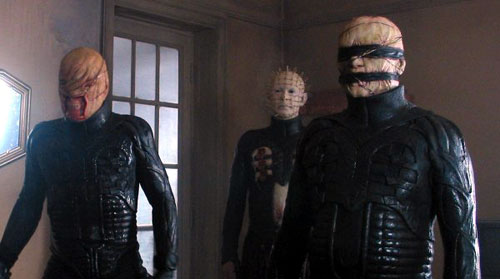
Up Next: Hellraiser: Revelations
DISCUSS THE FRANCHISE ON THE BOARDS
previous franchises battled
Critters
Death Wish
Leprechaun
Phantasm
Planet of the Apes
Police Academy
Rambo
Tremors